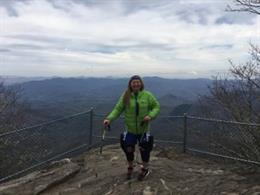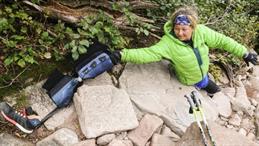Iron Will – The Opportunity of Adversity
 Justin Weppner, DO
Justin Weppner, DO
PGY4, University of Virginia
Most people would have given up under the pressure of adversity, but Stacey Kozel is not most people. The 41-year-old Medina, Ohio, resident completed hiking the entire 2,190 miles of the Appalachian Trail despite her incomplete paraparesis. From her electric wheelchair, she desperately searched the web for anything that could help. Eventually, she found the Ottobock C-brace. The C-brace functions as a mechanical exoskeleton with bendable knee joints that are equipped with sensors that measure the current position of the joint every .02 seconds. Between the lower knee and the foot is a carbon fiberglass spring, also equipped with a sensor that monitors ankle pressure. The C-brace is controlled by a built-in microprocessor, which receives information from the ankles and adjusts the hydraulic system that moves the leg.
 Initially, the $75,000 brace was denied by her insurance company. She didn’t stop appealing the decisions, though, and a year later with the help of her physiatrist, she was finally approved. The braces were strange at first, requiring her to relearn to walk utilizing her upper body for balance. When she put on a backpack, she thought she might tip over. But she quickly adjusted and managed to easily walk around the house, then the block, then the neighborhood. That’s when she decided to hike one of the longest hiking footpaths in the United States, stretching across 14 states from Georgia to Maine.
Initially, the $75,000 brace was denied by her insurance company. She didn’t stop appealing the decisions, though, and a year later with the help of her physiatrist, she was finally approved. The braces were strange at first, requiring her to relearn to walk utilizing her upper body for balance. When she put on a backpack, she thought she might tip over. But she quickly adjusted and managed to easily walk around the house, then the block, then the neighborhood. That’s when she decided to hike one of the longest hiking footpaths in the United States, stretching across 14 states from Georgia to Maine.
In March of 2016, she began the hike and was soon given her trail name “Iron Will.” “You’re never alone out there. You have a trail family, they call it,” she said. “For me, I’m slower, so we end up finishing the day in the same area, but it just takes me a lot more hours. You end up hiking with the same group of people.” Meanwhile, the C-braces help with the physical part, but they’re not perfect. When she faces boulders and steep inclines or embankments, she’ll throw her backpack ahead. Then she’ll sit and pull herself up backwards, scooting along. They also can’t get wet, and they require a new charge every 2 days. That’s where the “trail angels” come in, people who live along the trail and allow hikers to stop in for a night’s rest, a warm meal or, in Kozel’s case, a charge. Those braces are one of the reasons she chose to tackle the Appalachian trail. She wants other people who use wheelchairs to learn of the braces.
 As she wrote on Appalachian Trails:
As she wrote on Appalachian Trails:
“My goal is to bring awareness to these braces so people know they exist and hopefully it gives more people the ability to get out of their wheelchairs and out exploring the world. There are people that qualify for these braces that either do not know they exist or it gets stopped with an insurance denial. I hope WHEN I make it back to Mt. Katahdin on my thru hike, insurance companies will have a much tougher time telling others that the braces are not necessary.”
Kozel sees her impairments not as a barrier but as an opportunity.
“When you are faced with struggles it can have a way of showing you what is most important in life. I know when I am in the hospital bed and not knowing where my life is going it is easy to see what is most important. My determined personality is still the same despite my impairment. I now use that determination for learning how to walk or to find ways to make my body work for me. My prosthetist says walking is "falling forward and our leg swings out to catch us." I feel like I am practicing different ways to "fall" but still land on my feet. The trail was difficult because there are really no 2 steps that are the same. I don't think I look at paralysis as a barrier.”
Stacey completed her Appalachian Trail hike in July of 2016 and is considering hiking the Pacific Crest Trail in the future.